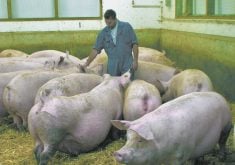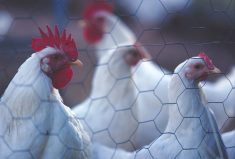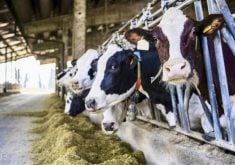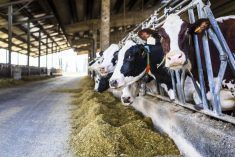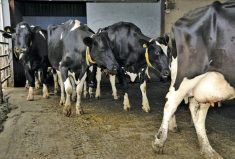Individual housing in hutches remains “the gold seal for health,” said a dairy farmer who recently switched to group housing for calves. But he insists the health drawbacks are manageable, and made the switch anyway for other reasons.
“Labour savings? Big plus. Animal welfare? Big plus,” declared Oxford County’s Thomas Jackson, who moved his calves into group pens in a converted milking barn in November, 2017, after taking advantage of the first instalment of the Dairy Farm Investment Program funding to purchase an automated nipple feeding system.
Read Also

BinSentry sensors reduce feed-bin outages
BinSentry sensors mean fewer feed bin outages and more efficient deliver for feed mills.
Why it matters: Research shows that what happens in calves when they are young can have a significant effect on their adult productivity, so farmers are putting more emphasis on calf housing.
Calf housing is a popular topic with organizers of both the Healthy Calf Conference by Ontario Veal Farmers and the Herd Management Conference of CanWest DHI. Both included sessions on their recent meeting agendas.
Research has shown that individual housing reduces contraction and spread of disease. For example, a University of California study involving 31 dairy farms of various sizes visited in the summer and early fall of 2014 found that “group housing was associated with increased odds of Bovine Respiratory Disease (BRD) compared to calves that were housed individually. Each additional calf in a pen was associated with a seven per cent increase in BRD.”
Goderich-based agriculture engineer Harold House of the DairyLogix consulting firm, the scheduled speaker at CanWest DHI’s recent Herd Management conference, has seen enough of those studies that he’s confident. “When it comes right down to it, you can’t beat hutches for calf health,” House told Farmtario.
That doesn’t mean, however, that House advises everyone to avoid group housing. He, too, recognizes the potential benefits in other areas. Inadequate ventilation, he insists, is the main reason calves can suffer in group housing scenarios. Get the ventilation right, and calves will have a much better chance of remaining healthy.
House says he has been steadily devoting more time to assisting producers with calf housing projects. “After a couple of years when there was quite a bit of new construction for the milking herds,” he offered, “it seems like, now, people are starting to do some catching up with their heifer and calf facilities.
“You’d think it wouldn’t be more difficult than if you’ve got a bunch of individual pens in the same barn but, unfortunately, it seems to be a lot more of a challenge in group housing situations to get the ventilation right.”
He said ventilation issues, though challenging, can be overcome.
University of Guelph Animal Biosciences Professor Trevor DeVries believes there’s more than just health that needs to be considered during the time that calves are receiving milk or milk replacer. As a speaker on the topic of calf housing at the recent Healthy Calf Conference in late November, he showed attendees results from research tracking the behaviour, growth, and health of young calves in relation to how they are housed early in life.

DeVries suggested that much of the recent trend towards group housing of calves on Ontario dairy farms has been based on labour savings and associated increased use of technology. He insists, though, that from a financial perspective, perhaps the most significant benefits come in the form of socialization and impacts on post-weaning weight gain and maintained health during that time.
DeVries says calves housed with other calves learn to eat solid food more quickly. And it’s not just that they learn to eat; they learn to eat in a manner that benefits them as they mature into the lactating herd — multiple small meals per day, as opposed to gulping down their food in just one or two feedings per day.
“Where you see most of that benefit (of group housing) is in and around the weaning period,” DeVries told Farmtario. “Calves that are reared socially from early on in life — and when I say ‘socially,’ it can be anything from larger groups down to calves raised in pairs — tend to start eating solid food earlier in life.” They also adapt more readily to new feeding regimes or new housing environments.
Jackson says his farm’s calves moved into their new environment at perhaps the riskiest time of the year — as the season moved from autumn into winter, with the resultant swings in temperature and humidity. But he recalls the transition went quite smoothly.
The capacity for his automated feeder, which supplies three separate nipples, is 60 calves. So far, he has maxed out at around 50 — split into three pens housing animals aged three days to two weeks, between two weeks and seven weeks, and from seven weeks to weaning. Newborns are housed individually for three days in the main dairy, where they receive colostrum.
On a recent visit to the Jackson farm, all the calves had blankets; the barn is kept a couple of degrees above freezing, and the pens are amply bedded with straw.
“It was a bit of a learning curve with the ventilation,” Jackson said. It was initially suggested he leave the sidewall curtain open a sliver in winter, but there was too much of a draft. He eventually realized the tube ventilation system was adequate to keep the air fresh, and now keeps the curtain closed.
In the summer, the curtain and doors are left open. Two large fans were installed atop the insulated room containing the automated feeder, angled down towards the pens housing the two younger age groups.
Milk for calves is pasteurized in the main barn, cooled to 3.5 C and transferred to an insulated stainless steel tank that’s transported once a day to the calf barn to supply the automated feeder. There’s no cooler on the tank, but Jackson says even on the hottest days of the summer the milk stayed cool enough throughout the day to prevent bacteria growth.
“We’re at 7-1/2 (litres per day) average right now, with about 40 calves from the three groups,” he said, after looking at the display screen on the automated feeder. The calves max out at nine litres per day in the two to-seven week age grouping.
Both DeVries and House advise easing into group housing, with no more than 10 animals in one pen, even if the automated feeder is rated to handle as many as 20.
“A potential recipe for problems is to build a new facility with big pens, and just throw a bunch of calves in there and expect them to do fine, if you have never previously managed calves in groups,” DeVries said.
Instead, perhaps start small in the pre-existing facility by creating some larger pens for smaller groups within a similar age range, and see how things go. Find out what works and what doesn’t work.
“Get your management of that down first before moving onto bigger and better things.”
House has some theories about why early adopters had trouble with large groups. Calves figure out where to go to avoid drafts or stale air, the ag engineer suggests, but if they’re in a group, some might not be able to compete to get to those locations. Instead, they’re forced to spend more time in poorly-ventilated portions of the pen. House has seen that calves often prefer to rest against a solid panel, where there’s probably less draft. In group housing, some calves will have no option but to rest in the middle of the pen.
If concerns about health and other issues prompt a move back to individual pens, House says there have been numerous recent innovations to keep in mind — which should be beneficial both for human working environment and animal welfare.
The Haanstras, also of Oxford County, have had a cover over their individual hutches for several years, and have expanded the simple building twice. There’s concrete in the middle and sand on both sides where the hutches are. “If you ask (Cees Haanstra), he’ll say he’d do it again,” House said, with some minor alterations including a concrete wall along the edge to push up against when cleaning, a little more space between the hutches and the outside wall, and some insulation in the roof.
The benefits of automated feeders are also becoming more and more available for individual housing systems. House says the Foerster-Technik rail feeder system has been adopted by a number of prominent robotic dairy equipment manufacturers, and there has been significant uptake in Ontario. And now there’s a new option from Uddermatic. “It’s a small company that I don’t think a lot of people know about, but their product is also quite innovative.”





